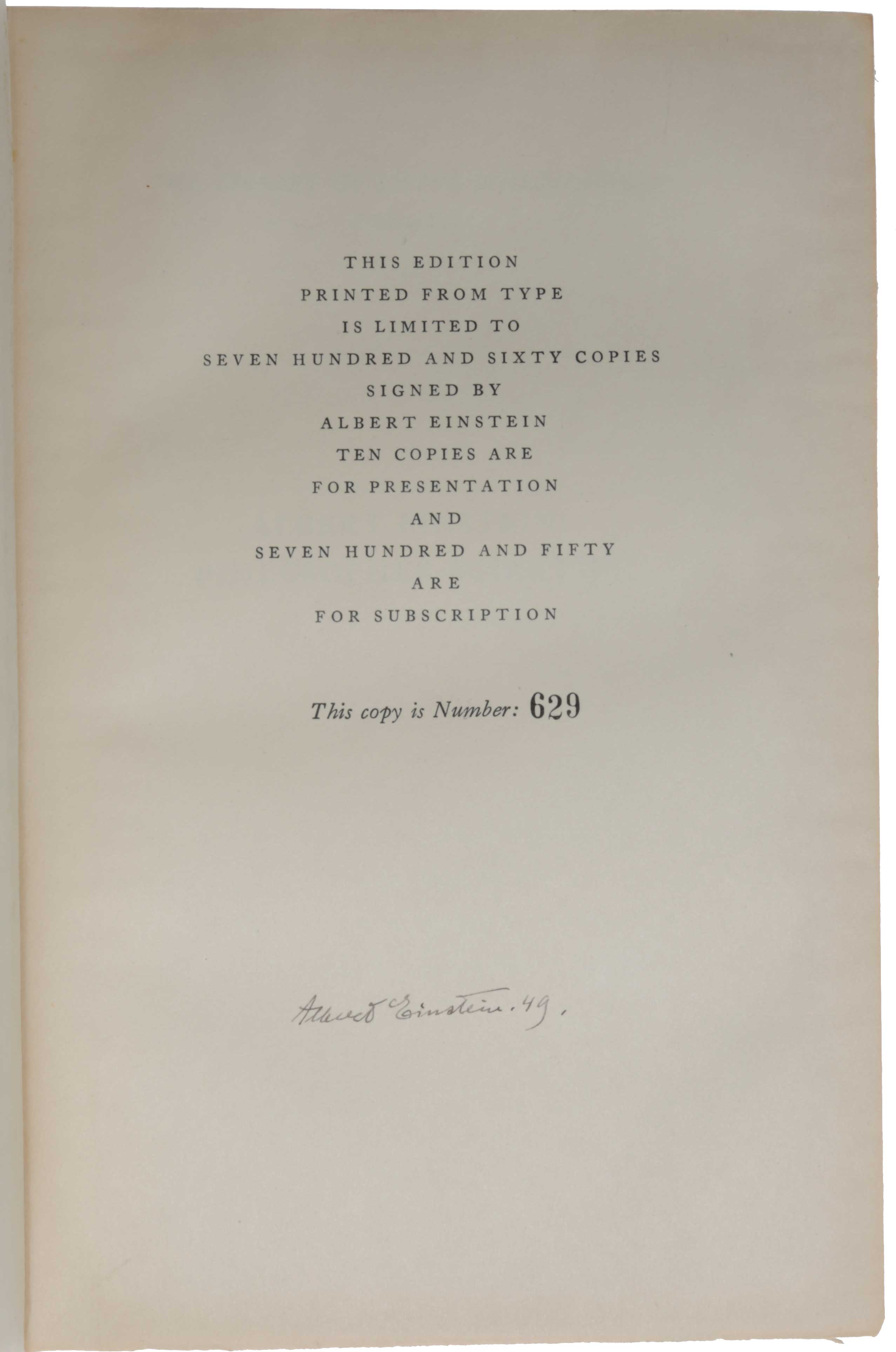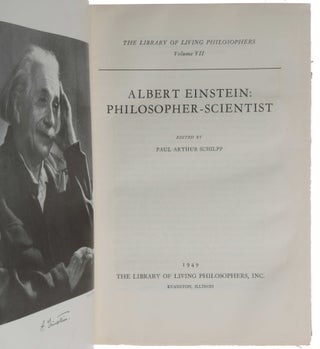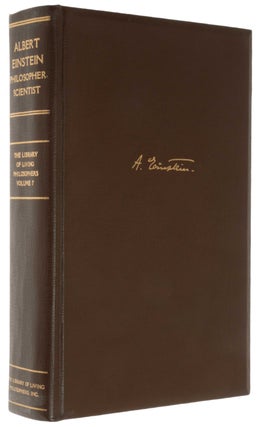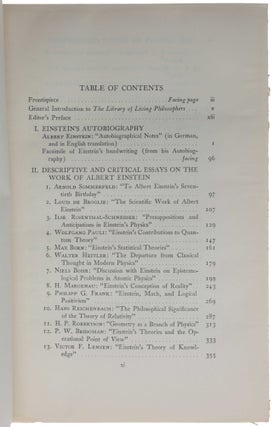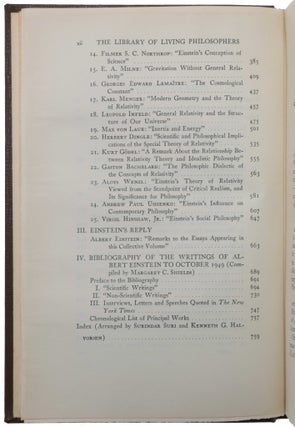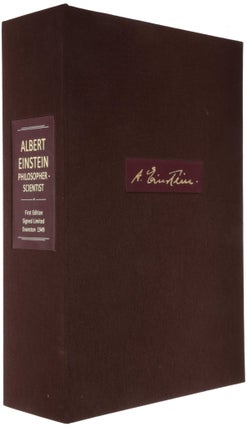Albert Einstein: Philosopher-Scientist. Paul Arthur Schilpp, Ed.
Evanston, IL: The Library Living Philosophers, 1949. First edition, number 629 of 760 numbered copies signed and dated by Einstein. This important volume contains Einstein’s autobiography, specially written for the book, and itself an important scientific contribution. It also includes a bibliography of his works, twenty-five scientists’ discussions of Einstein’s work and achievements, with Einstein’s response in his ‘Remarks Concerning the Essays Brought Together in this Co-Operative Volume’. Contributors of essays include Niels Bohr, Max Born, Wolfgang Pauli, and Kurt Gödel. Nobel laureate Isidore Rabi’s review hailed this as a most important and significant volume: “It is most difficult to get scientists to write simply and clearly about the fundamentals of their science and the leading philosophical ideas that guide them. Yet these very attitudes, preferences, and tastes are the fundamental ingredients which give quality, differentiation, and individuality to scientific creation and discovery” (Science 3 (1950), pp. 409-410). The book begins with Einstein’s ‘Autobiographical Notes’. “Everyone who knows Professor Einstein personally is all too well aware of his extreme shyness and his honest and forthright humility. I do not believe that there would have been one chance in ten thousand that the world would ever have secured an autobiography from the hand of Professor Einstein, if the unique nature of the Library of Living Philosophers had not finally convinced him of the worth-while-ness and significance of such an ‘obituary’, as he calls his autobiography. Einstein’s ‘Autobiographical Notes’ in themselves assure, therefore, the unique importance of this volume” (Preface, p. xiv). Perhaps the most famous contribution other than by Einstein himself is Bohr’s ‘Discussion with Einstein on Epistemological Problems in Atomic Physics’ – “Bohr’s account of his discussion with Einstein has been called ‘one of the great masterpieces of modern scientific reporting.’ According to Abraham Pais ‘nowhere in the literature can a better access to [Bohr’s] thinking be found’” (Jammer, Philosophy of Quantum Mechanics, p. 136). There is also Gödel’s ‘A Remark about the Relationship between Relativity Theory and Idealistic Philosophy,’ a seminal paper on the concept of time, which “appears to be the only published piece by Gödel that deals with philosophical issues not directly concerned with mathematics” (S. Feferman, Introductory note, Gödel’s Collected Works, Vol. II, p. 199). In Hans Reichenbach’s ‘The Philosophical Significance of the Theory of Relativity,’ the “argument over the nature and role of conventions in science … reach[ed] its highest level of sophistication … The question is whether the choice of a geometry is empirical, conventional, or a priori” (Stanford Encyclopedia of Philosophy). “In this book there is played out a great scientific drama of the last two decades. The central theme is not a matter which is strictly scientific. It is not whether quantum mechanics is correct in the sense that it gives a true or false description of physical phenomena. It is agreed that quantum mechanics has been extraordinarily fertile in predicting new phenomena which have been verified by experiment and that it has reconciled a whole host of seemingly contradictory experimental results. “The sole question is whether quantum mechanics is satisfactory from the philosophic and aesthetic point of view, and whether it is a good point of departure for a more profound understanding of physical phenomena. “The book starts with an intellectual autobiography by Einstein himself. He satirically calls it his obituary. It is a singularly moving and charming document. I know of no other to compare with it. Neither Newton nor Maxwell nor any of the other great giants of physics had his Schilpp to catalyse such an effort. After reading Einstein’s article one realises the great loss this is to scientific culture. “Einstein traces the development of his scientific attitudes frankly and objectively with many amusing digressions on education and other topics. He describes the crosscurrents of the scientific thinking of his day and the points of departure from which he made his great early contributions to statistics, quantum theory and relativity. It is an entrancing story. At the end it becomes manifest that relativity and field theory are his great loves. In these fields and modes of thought he finds real joy and comfort of spirit. Quantum theory, which has so completely pervaded the thinking of this age, leaves him quite cold. To him it is a provisional and useful structure but only, so to speak, ‘what to do till the doctor comes.’ Yet as becomes clear in later articles – particularly those of Bohr, Born, and Pauli – Einstein, almost more than anyone else after Planck, formulated the leading ideas on which quantum mechanics is founded. From a reading of Einstein’s article, one has the impression that he never permitted himself to grasp the importance and significance of his own tremendous contributions to quantum theory. “For all the revolution which he brought to modern physics, Einstein remains the great classicist. Statistics for him are a means of gaining knowledge in situations where one is of necessity ignorant of the precise values and properties of many of the variables. However, to introduce a statistical interpretation into the very fundamental relations of physics, into the simplest conceivable physical situations, is repugnant to him. It is best summed up in his statement that he is willing to believe that the dear God plays dice, but not according to fixed rules. “With this attitude, Einstein has withdrawn himself from the mainstreams of physics of the last two decades. He has devoted himself to what he believes will be the right path to the construction of a unified field theory, which will combine the gravitational and electromagnetic properties of matter. Such a program, if successful, would leave no room for such empirical constants as the electronic charge or mass or Planck’s constant; the charge quantization as well as energy quantization would come out directly as a consequence of the theory. It is a bold program, for which Einstein has found only a few followers. “Of the three founding fathers of quantum theory, Planck, Einstein and Bohr, Bohr remains as the leading protagonist and the acknowledged leader in this subtle discipline. He is also the great repository of quantum mechanical wisdom. His contribution to the book is a history of his discussions with Einstein on the fundamentals of quantum theory. With infinite charm and tact he describes Einstein’s profound criticisms of various aspects of quantum theory. The ingenious and subtle ways by which these objections have been answered are fully given by Bohr” (Rabi). Bohr’s decades-long debate with Einstein on the foundations of quantum physics is “one of the great scientific debates in the history of physics, comparable, perhaps, only to the Newton-Leibniz controversy of the early eighteenth century … In both cases it was a clash of diametrically opposed philosophical views … in both cases it was a clash between two of the greatest minds of their time” (Jammer, p. 120). “It is generally agreed that Bohr’s article of 1949, ‘Discussion with Einstein on Epistemological Problems in Physics’ [pp. 199-241] is his finest exposé on complementarity” (Pais, Niels Bohr’s Times, p. 428). The Bohr-Einstein debate began in 1920, when Bohr met Einstein in Berlin, and continued in 1927 at the fifth Solvay conference, where Einstein presented arguments to show that quantum mechanics was an inconsistent theory, arguments which Bohr refuted. At their next encounter, in 1930 at the following Solvay meeting in Brussels, Einstein informed Bohr that he had found a counterexample to the uncertainty relation between energy and time. “The argument was quite ingenious. Consider a box having in one of its walls a hole that can be opened or closed by a shutter controlled by a clock inside the box. The box is filled with radiation. Weigh the box. Open the shutter for a brief interval during which a single photon escapes. Weigh the box again, some time later. From the weight difference one can deduce the energy of the photon by using E = mc2. Thus (in principle) one has found to arbitrary accuracy both the photon energy and its time of passage, in conflict with the energy-time uncertainty relation. “Rosenfeld, who was in Brussels at that time, has recalled: ‘It was quite a shock for Bohr … he did not see the solution at once. During the whole evening he was extremely unhappy, going from one to the other and trying to persuade them that it couldn’t be true, that it would be the end of physics if Einstein were right; but he couldn’t produce any refutation. I shall never forget the sight of the two antagonists leaving [the Fondation Universitaire], Einstein a tall majestic figure, walking quietly, with a somewhat ironic smile, and Bohr trotting near him, very excited … The next morning came Bohr’s triumph.’ “The flaw Bohr had found was that Einstein had not taken into account that the weighing process amounts to observing the displacement of the box in a gravitational field ... The imprecision in the displacement of the box generates an uncertainty in the determination of the mass, and hence of the energy, of the photon. When the box is displaced then so is the clock inside which therefore ticks in a gravitational field slightly different from the one in the initial box position. Now Bohr noted the well-known fact that the rate of a clock depends in a specific way on its position in a gravitational field. Correspondingly the imprecision in the box displacement generates an uncertainty in the determination of time. Using the position-momentum uncertainty relation as input, Bohr could show that the uncertainties in energy and in time are just linked by the energy-time uncertainty relation. All was well. “Bohr’s version of the clock-in-the-box experiment was not published until 1949 when it appeared in a volume planned to be presented to Einstein on his 70th birthday” (Pais, pp. 427-8). “This episode was one of the highlights of the Bohr-Einstein debate – and this not only because of the dramatic features involved. It was also a turning point in Einstein’s attitude toward quantum mechanics. Accepting Bohr’s counterargument – for what could have been nearer to his heart than his own red-shift formula – he gave up any hope of refuting the quantum theory on the grounds of an internal inconsistency. Instead … after the 1930 Solvay Congress Einstein concentrated on demonstrating the incompleteness, rather than the inconsistency, of quantum mechanics” (Jammer, p. 136). “In July 1946, Schilpp asked Gödel to write an article (completed three years later) for the volume Albert Einstein: Philosopher-Scientist. This request prompted Gödel to return to his early interest in the foundations of physics, and thereby led him to publish two technical papers on the general theory of relativity (1949). Highly original and eventually quite influential, these papers gave the first rotating solutions to Einstein’s cosmological equations. The original solution put forward by Gödel permitted an observer, in principle, to travel into the past, while his later solutions (for an expanding universe) did not allow this. The article for Schilpp’s volume dealt with the relationship between relativity theory and Kantian philosophy. Gödel elaborated on this subject in a still unpublished paper, in which he argued that relativity justified certain aspects of Kant’s view of time. ‘Einstein told me,’ Oskar Morgenstern wrote in May 1972, ‘that Gödel’s papers were the most important ones on relativity theory since his own [Einstein’s] original paper appeared’” (DSB XVII: 356). The aim of Gödel’s paper is to show that the past and future exist statically and that time does not really pass. Gödel’s first point is that, given the relativity of simultaneity, it is impossible to slice space-time into a stack of ‘nows’ in any unique way, indicating that it is unrealistic to suppose that the world actually consists of such a series of fleeting ‘nows’ with the past and future non-existent. Gödel then goes on to describe an interesting model of the universe that he invented, in which ‘the local times of the special observers ... cannot be fitted together into one world time.’ This happens because Gödel's universes (i) contain individuals whose world lines appear to us to be a pattern of simultaneous events, and (ii) admit the logical possibility of traveling back to points in one's own past. “Consequently, the inference drawn above as to the non-objectivity of change doubtless applies at least in these worlds” (Rudy Rucker, Geometry, relativity and the fourth dimension, p. 131). Hans Reichenbach’s ‘The Philosophical Significance of the Theory of Relativity’ (pp. 287-311) vividly illustrates Einstein’s philosophy of physics. “The question is whether the choice of a geometry is empirical, conventional, or a priori. In his contribution, Reichenbach reasserted his old view that once an appropriate coordinating definition is established, equating some ‘practically rigid rod’ with the geometer’s ‘rigid body,’ then the geometry of physical space is wholly determined by empirical evidence: ‘The choice of a geometry is arbitrary only so long as no definition of congruence is specified. Once this definition is set up, it becomes an empirical question which geometry holds for physical space … The conventionalist overlooks the fact that only the incomplete statement of a geometry, in which a reference to the definition of congruence is omitted, is arbitrary’ (p, 297). “Einstein’s clever reply includes a dialogue between two characters, ‘Reichenbach’ and ‘Poincaré,’ in which ‘Reichenbach’ concedes to ‘Poincaré’ that there are no perfectly rigid bodies in nature and that physics must be used to correct for such things as thermal deformations, from which it follows that what we actually test is geometry plus physics, not geometry alone. Here an ‘anonymous non-positivist’ takes ‘Poincaré’s’ place, out of respect, says Einstein, ‘for Poincaré’s superiority as thinker and author’ (p. 677), but also, perhaps, because he realized that the point of view that follows was more Duhem than Poincaré. The ‘non-positivist’ then argues that one’s granting that geometry and physics are tested together contravenes the positivist identification of meaning with verifiability: ‘Non-Positivist: If, under the stated circumstances, you hold distance to be a legitimate concept, how then is it with your basic principle (meaning = verifiability)? Must you not come to the point where you deny the meaning of geometrical statements and concede meaning only to the completely developed theory of relativity (which still does not exist at all as a finished product)? Must you not grant that no “meaning” whatsoever, in your sense, belongs to the individual concepts and statements of a physical theory, such meaning belonging instead to the whole system insofar as it makes “intelligible” what is given in experience? Why do the individual concepts that occur in a theory require any separate justification after all, if they are indispensable only within the framework of the logical structure of the theory, and if it is the theory as a whole that stands the test?’ (p. 678)” (Stanford Encyclopedia of Philosophy).
8vo (237 x 160 mm), pp. xvi, 781, with 8 figures in text, photographic frontispiece after Yousuf Karsh, photographic and facsimile illustrations, limitation statement on the front free endpaper. Original brown cloth, top edge gilt, publisher’s slipcase. Very fine, with the fragile slipcase in excellent condition.
Item #5706
Price: $15,000.00

